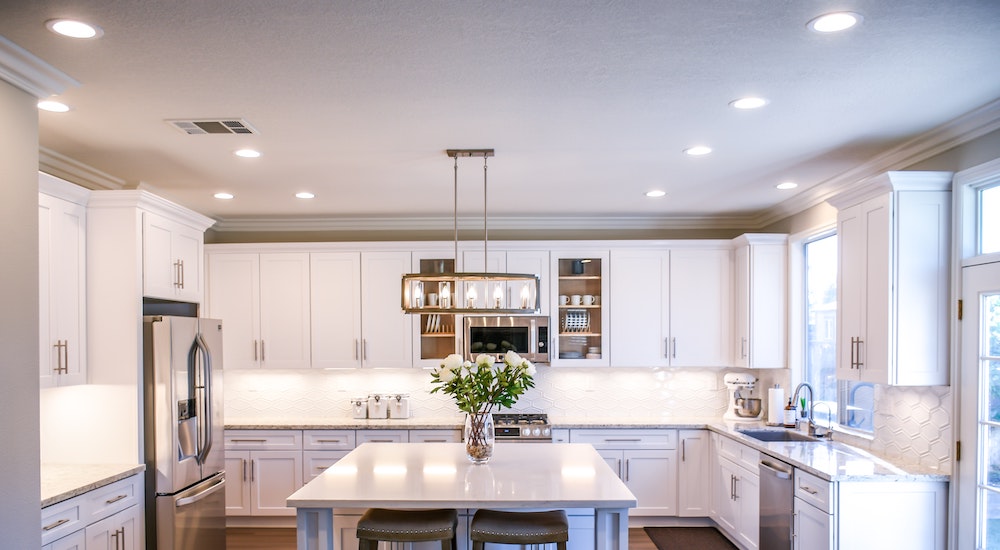How Many Downlights Do I Need in a Kitchen?

If you're looking to brighten up your culinary space with the perfect kitchen downlights, you've come to the right place.
This post will explore the world of downlighting for kitchens and help you figure out just how many recessed lights you need to create that perfect, well-lit kitchen.
From balancing aesthetics to functionality, we've got you covered.
How Many Downlights Do I Need in a Kitchen?
The number of downlights you need in a kitchen depends on factors like size, layout, and personal preference.
As a general rule, you should aim for one downlight every 1.5 to 2 square meters (16 to 21 square feet) for even illumination.
However, it's essential to consider task lighting for specific areas like countertops, the hob, and the sink.
To determine the optimal number of downlights for your kitchen, follow these steps:
Measure your kitchen's area (length x width) in square meters or square feet.
Divide the area by 1.5 to 2 (m²) or 16 to 21 (ft²) to get an approximate number of downlights needed.
Consider adding extra downlights for task lighting in key areas.
Remember, this is a general guideline, and it's crucial to tailor your lighting plan to your specific kitchen's layout and requirements.
Consult a lighting professional if needed for the best results.
What Factors Affect the Number of Downlights Need for a Kitchen?
Several factors affect the number of downlights needed for a kitchen:
- Size: Larger kitchens require more downlights to ensure even and adequate illumination.
- Layout: The arrangement of countertops, cabinets, and appliances can impact lighting requirements, as some areas may need focused task lighting.
- Ceiling height: Higher ceilings might necessitate more downlights to achieve the desired brightness at work surfaces.
- Natural light: If your kitchen has ample natural light from windows or skylights, you may need fewer downlights.
- Personal preference: The desired brightness and ambience can vary from person to person, influencing the number of downlights.
- Downlight brightness and beam angle: The brightness (lumens) and beam angle of the downlights you choose can affect coverage, which in turn impacts the number of fixtures needed.
And finally the 7th and probably the most important one… Especially with the cost of living going through the roof… (no pun intended)
7. Energy efficiency: The efficiency of the downlights can influence how many you need, as energy-efficient LEDs provide more light output with fewer fixtures.
Where Should Downlights Be in Your Kitchen?
To create a well-lit and functional kitchen, consider these guidelines for placing downlights:
- General lighting: Space downlights evenly throughout the kitchen, aiming for 1.5 to 2 square metres (16 to 21 square feet) of coverage per downlight.
- Task lighting: Place downlights above key work areas, such as countertops, the hob, and the sink. Position them close enough to provide focused light without casting shadows from your body.
- Accent lighting: Highlight special features like display cabinets, artwork, or open shelving with strategically placed downlights.
- Walkways: Ensure that pathways and high-traffic areas are well-lit for safety and ease of movement.
Remember, it's essential to adapt these guidelines to your kitchen's specific layout and requirements.
Consulting a lighting professional can help achieve the best results.
Which Are Better Halogen for LED Downlights for a Kitchen?
LED downlights are generally a better choice for kitchens compared to halogen downlights, and here's why:
- Energy efficiency: LED downlights consume less energy than halogen ones, reducing your electricity bills and carbon footprint.
- Longevity: LEDs have a longer lifespan (up to 50,000 hours) compared to halogen bulbs (2,000 to 4,000 hours), meaning less frequent replacements and lower maintenance costs.
- Heat emission: LEDs produce less heat than halogen lights, making them safer and reducing the risk of overheating in your kitchen.
- Colour rendering: Modern LED downlights offer excellent colour rendering, accurately reproducing the colours in your kitchen.
- Dimmable options: Many LED downlights are compatible with dimmer switches, giving you greater control over the brightness and ambience.
Considering these advantages, LED downlights are a more practical, cost-effective, and environmentally friendly choice for your kitchen.
How Far Apart Should Recessed Lights Be in a Kitchen?
The ideal distance between recessed lights in a kitchen depends on factors like the room size, layout, and desired brightness.
However, as a general guideline, you can follow these steps:
Divide the ceiling height by 2. This gives you a rough estimate of the distance between recessed lights.
For example, if your ceiling is 2.4 metres (8 feet) high, you should space the lights about 1.2 metres (4 feet) apart.
Ensure even lighting by placing recessed lights at an equal distance from each other and the walls.
For task lighting over countertops, the hob, and the sink, position recessed lights closer to avoid casting shadows while working.
Remember, these are general guidelines, and it's crucial to tailor the lighting plan to your specific kitchen layout and requirements.
We always recommend consulting with a lighting professional if needed to get optimal results from your downlights.
Does the Ceiling Height Affect How Many Downlights You Will Need?
The ceiling height can affect how many downlights you will need in your kitchen.
Higher ceilings generally require more downlights to achieve the desired level of brightness at the work surfaces.
As the distance between the ceiling and the working area increases, the light beam will spread more, resulting in less focused illumination.
To compensate for this, you may need additional downlights or downlights with a higher lumen output.
When planning your kitchen lighting, take ceiling height into account and consult a lighting professional if needed to ensure optimal brightness and coverage.
What Are Lumens and Why Are They Important for Kitchen Lighting?
Lumens are a measure of the total amount of visible light emitted by a source, such as a light bulb or fixture.
They are important for kitchen lighting because they help you determine the brightness of the lights you're installing.
A higher lumen output means a brighter light, while a lower lumen output results in a dimmer light.
In a kitchen, having the right amount of lumens is crucial for both aesthetics and functionality, as it ensures adequate illumination for tasks like cooking, food prep, and cleaning while creating a comfortable and inviting atmosphere.
When selecting kitchen lighting, consider the size, layout, and specific lighting needs of your space to choose downlights or fixtures with the appropriate lumen output.
It's also worth noting that LED lights typically provide more lumens per watt, making them a more energy-efficient choice.
What is Plinth Lighting for Kitchens?
Plinth lighting, also known as toe-kick or skirting lighting, is a type of accent lighting used in kitchens to illuminate the space beneath base cabinets or kitchen island units.
These low-level lights are installed on the plinth or toe-kick area at the bottom of the cabinets, close to the floor.
Plinth lighting serves several purposes:
- Aesthetic appeal: It adds a touch of elegance and ambience to your kitchen, creating a warm and inviting atmosphere.
- Visual depth: Plinth lighting enhances the perception of space and depth in your kitchen, making it appear larger and more open.
- Safety and navigation: The soft glow from plinth lights can serve as a subtle nightlight, guiding your way through the kitchen in low-light conditions without the need for bright overhead lighting.
- Accentuation: Plinth lighting can highlight specific design features or architectural elements in your kitchen.
These lights are typically energy-efficient LEDs and come in various colours and styles to suit your kitchen design and personal preference.
Tips From an Expert Kitchen Fitter
Here are 5 top tips from an expert kitchen fitter about fitting kitchen downlights:
- Plan ahead: Before installing downlights, carefully plan the layout to ensure even illumination and proper task lighting. Consider factors like the size and layout of your kitchen, work areas, and natural light sources.
- Choose the right downlights: Opt for energy-efficient LED downlights with the appropriate lumen output and beam angle for your kitchen's size and requirements.
- Maintain consistency: To achieve a professional look, use downlights with the same colour temperature (measured in Kelvins) throughout your kitchen. This will ensure a uniform appearance and avoid any mismatched lighting.
- Avoid glare: Position downlights in a way that minimises glare on shiny surfaces, such as glass cabinets, stainless steel appliances, or polished countertops.
- Seek professional advice: If you're unsure about the best lighting plan for your kitchen, consult a lighting professional or an experienced kitchen fitter.
They can help you make the right choices and ensure proper installation for optimal results.
Following these tips will help you create a well-lit, functional, and aesthetically pleasing kitchen space that you'll enjoy for years to come.
Final Notes On How Many Downlights You Need In the Kitchen?
To achieve a well-lit and functional kitchen, it's essential to carefully plan your downlight placement, considering factors like size, layout, and work areas.
Opt for energy-efficient LED downlights with the appropriate lumen output and beam angle, and maintain consistency in colour temperature.
Be mindful of glare on shiny surfaces, and seek professional advice if needed.
By following these expert tips, you'll create an inviting and practical kitchen environment that not only enhances your cooking experience but also adds to the overall appeal of your home.


